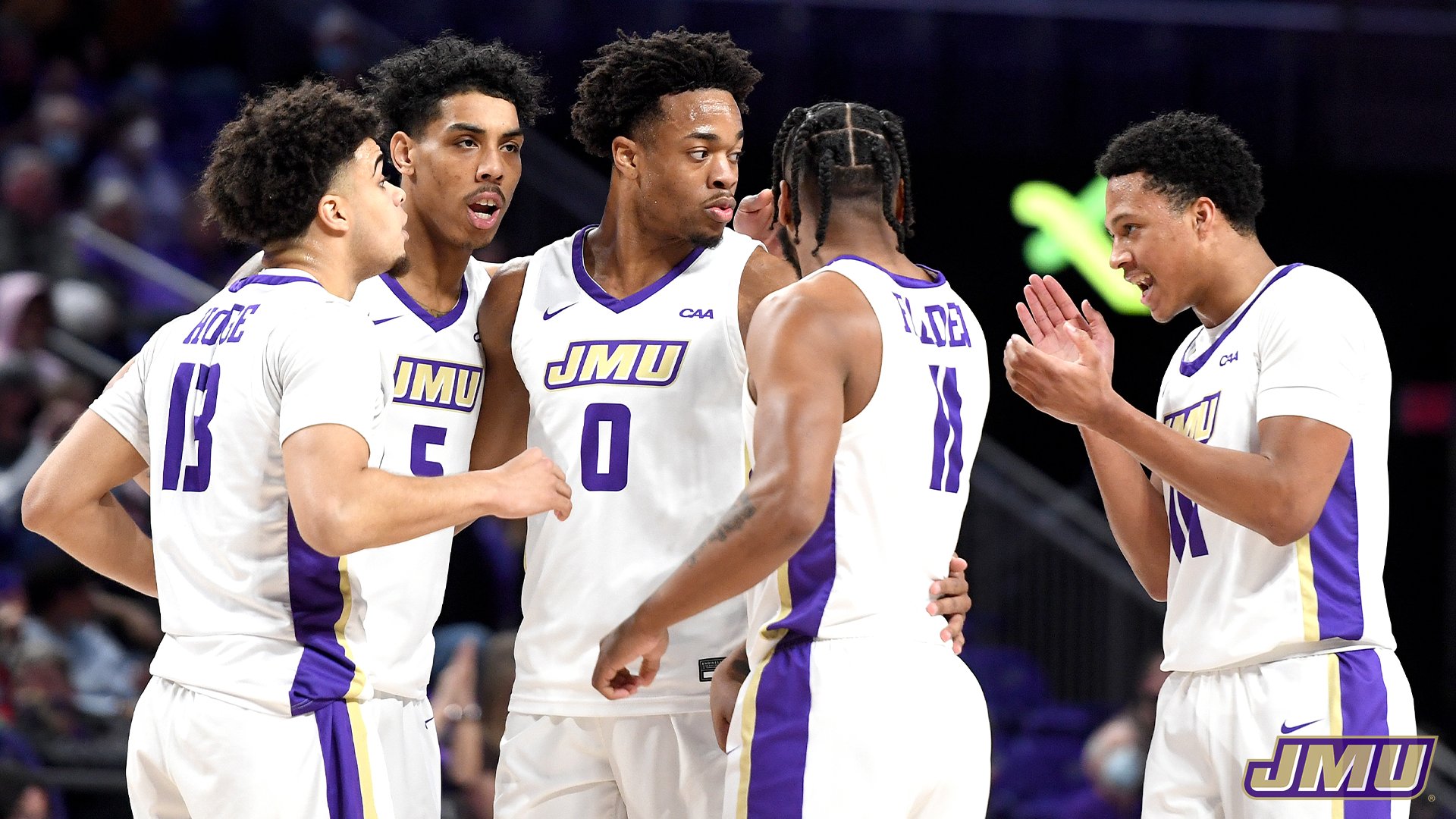Image courtesy of JMU Athletics Communications
By Bennett Conlin
JMU men’s basketball started its season with a glorified exhibition as the Dukes manhandled Carlow 135-40. The Dukes’ season ended with another lopsided outcome, only JMU found itself on the other side of the equation in late February.
Mark Byington’s team wrapped up the year with an atrocious 95-59 loss to Towson. The season can’t really be described as a rollercoaster because that would imply multiple ups and downs. Perhaps a quick turn on a seesaw better describes JMU’s year, which included an incredible nonconference record followed by a jarringly poor conference performance.
After opening with a win over Carlow, JMU beat Old Dominion, George Mason, and Virginia (!) in nonconference play. The Dukes were 9-2 before entering a COVID-19 pause and then starting conference play.
CAA play was a mess.
The Dukes dealt with the initial COVID pause and several key injuries. Takal Molson and Terrell Strickland, a pair of important contributors at the guard spots, suffered season-ending injuries during CAA play, and other players, including Alonzo Sule and Charles Falden, dealt with less severe injuries.
In the end, JMU ended the season 15-14, going 6-12 in CAA play. As of Sunday, the Dukes rank 233rd in KenPom. Earlier in the season, JMU reached No. 155 in the advanced metric system’s rankings.
Was it a good season?
Expectations for JMU men’s basketball are alarmingly low, but those low expectations are earned. After really solid play in the 1970s and 80s, the Dukes started to fade as a program by 2000, and they haven’t been a mid-major force in decades.
Since 1994-95, the Dukes have made the NCAA Tournament once, and they were a No. 16 seed when they made the Big Dance in 2012-13. JMU hasn’t been a good men’s basketball school in a long, long time.
In my opinion, it was a good season, albeit one with a disappointing ending. JMU defeated Old Dominion, George Mason, and Virginia! That’s an incredible group of nonconference wins.
JMU needs to take steps forward as a program.
Showing signs of life in the nonconference is a step forward. Averaging 4,408 fans per home game is a step forward. Posting consecutive winning seasons is a step forward.
It was a good season for the current state of JMU’s program, especially when factoring in injuries and the demotivating factor of the Dukes being banned from the CAA Tournament. It’s hard to stay motivated without much to play for, and JMU really didn’t have anything on the line in the final few weeks of the season.
What’s needed for improvement?
Clearly, if going 15-14 is considered a “good season” JMU needs to improve. The No. 1 area for improvement is the low post.
According to KenPom, JMU is one of the 15 worst teams nationally at defending 2-point shots. During CAA play, the Dukes had the worst defensive efficiency of any conference team. They gave up too many offensive rebounds, didn’t block shots, and couldn’t defend the paint.
JMU needs better post play, but the Dukes’ roster in 2021-22 didn’t have a true big man. Sule works well as a power forward or an occasional center in a small lineup, but having Sule, Justin Amadi, and Julien Wooden playing the center spot isn’t an ideal situation. The players are better served as small forwards or power forwards.
Arguably the biggest question facing JMU this offseason is the plan at center. Falden is the only player without remaining eligibility, but a few players could always transfer out of the program.
If left with open scholarships, how does Byington manage his roster to improve the issues in the post?
The next step
JMU fans desperately want a good men’s basketball program. The interest was evident after the UVA win, which captivated more casual basketball fans who often spend their time focused on the football team’s success.
As JMU enters the Sun Belt — an average basketball conference — the opportunity is there for the Dukes to start making the NIT and the NCAA Tournament regularly. The home atmosphere has a chance to be a noticeable advantage, and the Dukes’ athletic department has the resources to build a winner.
In the immediate future, the goal needs to be to add post presence. Incoming freshman Jerrell Roberson should help with that, as he’s 6’9″ with rebounding and shot-blocking ability. He’s an exciting addition and has the potential to contribute immediately.
Realistically, however, JMU needs more than just Roberson to improve in the post. That addition may very well come through the portal. Pairing players like Roberson, Sule, Wooden, and Amadi with a transfer center could make JMU an NCAA Tournament team.
When taking a long-term view of the program, the next step is making a relevant postseason tournament. To become a meaningful mid-major, a team needs to play meaningful games. Makes sense, right? Those come in the NIT and NCAA Tournament.
You can’t fabricate meaningful matchups, and as nice as the win over Virginia was, the Cavaliers look like an NIT-bound program this year. One home win over an NIT team doesn’t make a season.
Byington has JMU heading in a positive direction, but the end to this season makes it clear JMU has a long way to go to become a consistently competitive mid-major program.


Leave a Reply